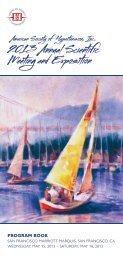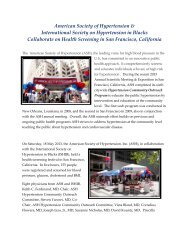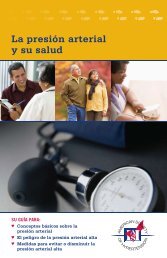2010 Annual Scientific Meeting and Exposition 2010 Annual ...
2010 Annual Scientific Meeting and Exposition 2010 Annual ...
2010 Annual Scientific Meeting and Exposition 2010 Annual ...
Create successful ePaper yourself
Turn your PDF publications into a flip-book with our unique Google optimized e-Paper software.
7 DRUG INTERACTIONSNo drug interaction studies have been conducted with Valturna <strong>and</strong> other drugs,although studies with the individual aliskiren <strong>and</strong> valsartan components aredescribed below.AliskirenEffects of Other Drugs on AliskirenBased on in vitro studies, aliskiren is metabolized by CYP 3A4.Irbesartan: Coadministration of irbesartan reduced aliskiren C max up to 50% aftermultiple dosing.P-glycoprotein Effects: Pgp (MDR1/Mdr1a/1b) was found to be the major effluxsystem involved in absorption <strong>and</strong> disposition of aliskiren in preclinical studies.The potential for drug interactions at the Pgp site will likely depend on the degreeof inhibition of this transporter. Coadministration of aliskiren with Pgp substratesor weak to moderate inhibitors such as atenolol, digoxin, <strong>and</strong> amlodipine did notresult in clinically relevant interactions.Atorvastatin: Coadministration of atorvastatin, a weak Pgp inhibitor, resulted inabout a 50% increase in aliskiren C max <strong>and</strong> AUC after multiple dosing.Ketoconazole: Coadministration of 200 mg twice-daily ketoconazole, a moderatePgp inhibitor, with aliskiren resulted in approximate 80% increase in plasma levelsof aliskiren. A 400-mg once-daily dose was not studied but would be expectedto increase aliskiren blood levels further.Cyclosporine: Coadministration of 200 mg <strong>and</strong> 600 mg cyclosporine, a potentPgp inhibitor, with 75 mg aliskiren resulted in an approximately 2.5-fold increasein C max <strong>and</strong> 5-fold increase in AUC of aliskiren. Concomitant use of aliskiren withcyclosporine is not recommended.Verapamil: Coadministration of 240 mg of verapamil, a moderate Pgp inhibitor,with 300 mg aliskiren resulted in an approximately 2-fold increase in C max <strong>and</strong>AUC of aliskiren. However, no dosage adjustment is necessary.Drugs with no clinically significant effects: Coadministration of lovastatin,atenolol, warfarin, furosemide, digoxin, celecoxib, hydrochlorothiazide, ramipril,valsartan, metformin <strong>and</strong> amlodipine did not result in clinically significantincreases in aliskiren exposure.Effects of Aliskiren on Other DrugsAliskiren does not inhibit the CYP450 isoenzymes (CYP1A2, 2C8, 2C9, 2C19,2D6, 2E1, <strong>and</strong> CYP 3A) or induce CYP 3A4.Furosemide: When aliskiren was coadministered with furosemide, the AUC <strong>and</strong>C max of furosemide were reduced by about 30% <strong>and</strong> 50%, respectively. Patientsreceiving furosemide could find its effect diminished after starting aliskiren.Drugs with no clinically significant effects: Coadministration of aliskiren did notsignificantly affect the pharmacokinetics of lovastatin, digoxin, valsartan, amlodipine,metformin, celecoxib, atenolol, atorvastatin, ramipril or hydrochlorothiazide.Warfarin: The effects of aliskiren on warfarin pharmacokinetics have not beenevaluated.ValsartanNo clinically significant pharmacokinetic interactions were observed whenvalsartan was coadministered with aliskiren, amlodipine, atenolol, cimetidine,digoxin, furosemide, glyburide, hydrochlorothiazide, or indomethacin. Thevalsartan-atenolol combination was more antihypertensive than either component,but it did not lower the heart rate more than atenolol alone.Warfarin: Coadministration of valsartan <strong>and</strong> warfarin did not change the pharmacokineticsof valsartan or the time-course of the anticoagulant properties ofwarfarin.CYP 450 Interactions: In vitro metabolism studies have indicated that CYP450mediated drug interactions between valsartan <strong>and</strong> coadministered drugs areunlikely because of low extent of metabolism [see Pharmacokinetics – Valsartan(12.3) in the full prescribing information].Transporters: The results from an in vitro study with human liver tissue indicatethat valsartan is a substrate of the hepatic uptake transporter OATP1B1 <strong>and</strong> thehepatic efflux transporter MRP2. Coadministration of inhibitors of the uptaketransporter (rifampin, cyclosporine) or efflux transporter (ritonavir) may increasethe systemic exposure to valsartan.









